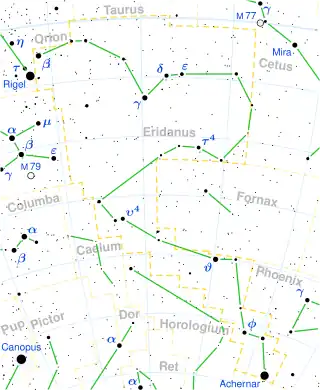f Eridani
f Eridani is a binary,[10] or possibly a triple, star system in the equatorial constellation of Eridanus, consisting of stars HD 24071 and HD 24072. They share a single Hipparcos catalogue entry, HIP 17797, but have separate Bright Star Catalogue listings, HR 1189 and 1190. f Eridani is the Bayer designation of the pair.
 Location shown, annotated: f | |
| Observation data Epoch J2000 Equinox J2000 | |
|---|---|
| Constellation | Eridanus |
| HD 24072 | |
| Right ascension | 03h 48m 35.87402s[1] |
| Declination | −37° 37′ 12.5158″[1] |
| Apparent magnitude (V) | 4.721±0.009[2] |
| HD 24071 | |
| Right ascension | 03h 48m 35.47769s[3] |
| Declination | −37° 37′ 19.2124″[3] |
| Apparent magnitude (V) | 5.246±0.009[2] |
| Characteristics | |
| HD 24072 | |
| Spectral type | B9.5 Van[4] |
| HD 24071 | |
| Spectral type | A1 Va[4] |
| Variable type | suspected[5] |
| Astrometry | |
| HD 24072 | |
| Proper motion (μ) | RA: +81.136[1] mas/yr Dec.: −6.795[1] mas/yr |
| Parallax (π) | 18.8093 ± 0.2220 mas[1] |
| Distance | 173 ± 2 ly (53.2 ± 0.6 pc) |
| Absolute magnitude (MV) | 1.194±0.190[2] |
| HD 24071 | |
| Proper motion (μ) | RA: +63.372[3] mas/yr Dec.: −8.121[3] mas/yr |
| Parallax (π) | 18.7976 ± 0.0582 mas[3] |
| Distance | 173.5 ± 0.5 ly (53.2 ± 0.2 pc) |
| Absolute magnitude (MV) | 1.719±0.190[2] |
| Details | |
| HD 24072 | |
| Mass | 2.6[6] M☉ |
| Radius | 2.0[6] R☉ |
| Luminosity | 35[6] L☉ |
| Surface gravity (log g) | 4.26[6] cgs |
| Temperature | 10.046[6] K |
| Rotational velocity (v sin i) | 225[7] km/s |
| Age | 45±4[2] Myr |
| HD 24071 | |
| Mass | 2.1[3] M☉ |
| Radius | 1.7[3] R☉ |
| Luminosity | 20[3] L☉ |
| Surface gravity (log g) | 4.16[3] cgs |
| Temperature | 9,503[3] K |
| Metallicity [Fe/H] | −1.47[3] dex |
| Rotational velocity (v sin i) | 39[7] km/s |
| Age | 45±4[2] Myr |
| Other designations | |
| HD 24072: HR 1190, SAO 194551[8] | |
| HD 24071: HR 1189, SAO 194550[9] | |
| Database references | |
| SIMBAD | data |
| HD 24072 | |
| HD 24071 | |
f Eridani is visible to the naked eye as a single star with a magnitude of 4.25.[11] HD 24071 has an apparent visual magnitude of 5.25 and HD 24072 a magnitude of 4.72.[2] As of 2009, the pair had an angular separation of 8.40″ along a position angle of 216°.[12] Both stars have an annual parallax shift 18.8 mas, which provides a distance estimate to the system of 173 light years. The pair are members of the Tucana-Horologium moving group, a 45 million year old set of stars that share a common motion through space.[2]
The brighter component, HD 24072, is a B-type main-sequence star with a classification of B9.5 Van.[4] The n suffix indicates "nebulous" absorption lines which are caused by its rapid rotation. It has a projected rotational velocity of 225 km/s.[7]
HD 24071 may itself be a spectroscopic binary. The visible component is an A-type main-sequence star with a stellar classification of A1 Va.[4] It is a suspected variable star of unknown type showing an amplitude of 0.05 magnitude,[5] and is a source of X-ray emission, which may originate from a companion of class G2-5V.[13]
References
- Vallenari, A.; et al. (Gaia collaboration) (2023). "Gaia Data Release 3. Summary of the content and survey properties". Astronomy and Astrophysics. 674: A1. arXiv:2208.00211. Bibcode:2023A&A...674A...1G. doi:10.1051/0004-6361/202243940. S2CID 244398875. Gaia DR3 record for this source at VizieR.
- Bell, Cameron P. M.; et al. (November 2015), "A self-consistent, absolute isochronal age scale for young moving groups in the solar neighbourhood", Monthly Notices of the Royal Astronomical Society, 454 (1): 593–614, arXiv:1508.05955, Bibcode:2015MNRAS.454..593B, doi:10.1093/mnras/stv1981, S2CID 55297862.
- Vallenari, A.; et al. (Gaia collaboration) (2023). "Gaia Data Release 3. Summary of the content and survey properties". Astronomy and Astrophysics. 674: A1. arXiv:2208.00211. Bibcode:2023A&A...674A...1G. doi:10.1051/0004-6361/202243940. S2CID 244398875. Gaia DR3 record for this source at VizieR.
- Gray, R. O.; Garrison, R. F. (December 1987), "The Early A-Type Stars: Refined MK Classification, Confrontation with Stroemgren Photometry, and the Effects of Rotation", Astrophysical Journal Supplement, 65: 581, Bibcode:1987ApJS...65..581G, doi:10.1086/191237.
- Adelman, S. J.; et al. (November 2000), "On the Variability of A0-A2 Luminosity Class III-V Stars", Information Bulletin on Variable Stars, 4984: 1, Bibcode:2000IBVS.4984....1A.
{{citation}}: CS1 maint: multiple names: authors list (link) - Stassun, Keivan G.; et al. (9 September 2019). "The Revised TESS Input Catalog and Candidate Target List". The Astronomical Journal. 158 (4): 138. arXiv:1905.10694. Bibcode:2019AJ....158..138S. doi:10.3847/1538-3881/ab3467. ISSN 0004-6256.
- Royer, F.; et al. (October 2002), "Rotational velocities of A-type stars in the northern hemisphere. II. Measurement of v sin i", Astronomy and Astrophysics, 393: 897–911, arXiv:astro-ph/0205255, Bibcode:2002A&A...393..897R, doi:10.1051/0004-6361:20020943, S2CID 14070763.
- "HD 24072". SIMBAD. Centre de données astronomiques de Strasbourg. Retrieved 2018-07-22.
- "HD 24071". SIMBAD. Centre de données astronomiques de Strasbourg. Retrieved 2018-07-22.
- Eggleton, P. P.; Tokovinin, A. A. (2008), "A catalogue of multiplicity among bright stellar systems", Monthly Notices of the Royal Astronomical Society, 389 (2): 869, arXiv:0806.2878, Bibcode:2008MNRAS.389..869E, doi:10.1111/j.1365-2966.2008.13596.x, S2CID 14878976.
- Mallama, A. (2014). "Sloan Magnitudes for the Brightest Stars". The Journal of the American Association of Variable Star Observers. 42 (2): 443. Bibcode:2014JAVSO..42..443M.
- Mason, B. D.; et al. (2014), "The Washington Visual Double Star Catalog", The Astronomical Journal, 122 (6): 3466, Bibcode:2001AJ....122.3466M, doi:10.1086/323920
- Schröder, C.; Schmitt, J. H. M. M. (November 2007), "X-ray emission from A-type stars", Astronomy and Astrophysics, 475 (2): 677–684, Bibcode:2007A&A...475..677S, doi:10.1051/0004-6361:20077429.